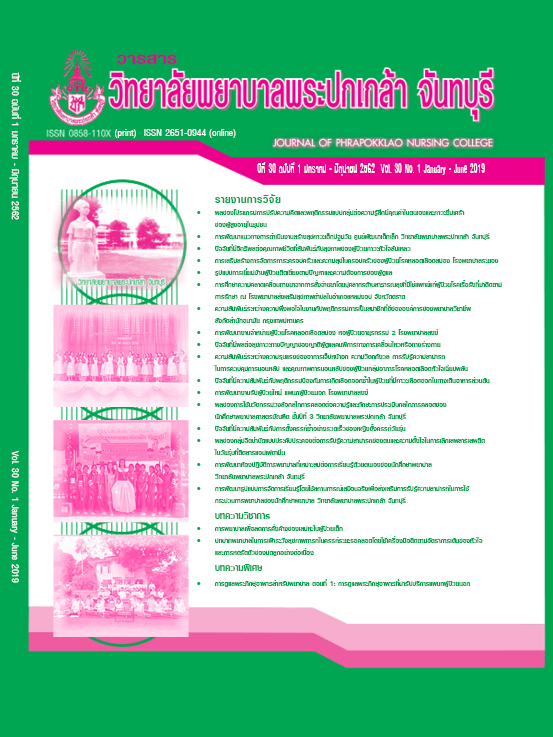Relationships between Cardiac Pain Intensity, Anxiety, Perceived Control of Sleep, and Quality of Sleep among Acute Coronary Syndrome Patients
Keywords:
Cardiac pain intensity, Anxiety, Perceived control of sleep, Quality of sleep, Acute coronary syndromeAbstract
This descriptive correlational research aimed to examine the relationships between cardiac pain intensity, anxiety, perceived control of sleep, and quality of sleep among acute coronary syndrome (ACS) patients. The samples consisted of 90 ACS patients receiving follow-up service at cardiovascular clinic, Chon Buri Hospital. The research instruments were composed of a questionnaire of demographic data, an assessment form of cardiac pain intensity, an assessment form of anxiety with the reliability of .70, a questionnaire of perceived control of sleep with the reliability of .88, and a questionnaire of quality of sleep with the reliability of .81. Data were collected from November, 2015 to April, 2016. Statistics used for data analysis included frequency, percentage, mean, standard deviation, and Pearson’s product moment correlation coefficient.
The research results revealed that cardiac pain intensity was negatively statistically significant related to quality of sleep (r = -.217, p < .05) and perceived control of sleep was positively statistically significant related to quality of sleep (r = .286, p < .01).
This research suggests that nursing professionals should enhance perceived control of sleep as well as evaluate and reduce cardiac pain intensity among ACS patients in order to raise their quality of sleep.
References
เกรียงไกร เฮงรัศมี. (2554). มาตรฐานการรักษาผู้ป่วยกล้ามเนื้อหัวใจขาดเลือดเฉียบพลัน. นนทบุรี: สถาบันโรคทรวงอก กรมการแพทย์.
ชนกพร จิตปัญญา. (2543). มโนมติและการวัดการนอนหลับ. วารสารพยาบาลศาสตร์ จุฬาลงกรณ์มหาวิทยาลัย, 12(1), 1-9.
ณัฐชา พัฒนา. (2555). ผลของโปรแกรมการสนับสนุนทางสังคมต่อความวิตกกังวลและความพึงพอใจของผู้ป่วยกล้ามเนื้อหัวใจตายเฉียบพลันในหอผู้ป่วยวิกฤติ (วิทยานิพนธ์ปริญญามหาบัณฑิต). ชลบุรี: มหาวิทยาลัยบูรพา.
ธนา นิลชัยโกวิทย์, มาโนช หล่อตระกูล, และอุมาภรณ์ ไพศาลสุทธิเดช. (2539). การพัฒนาแบบสอบถาม Hospital Anxiety and Depression Scale ฉบับภาษาไทยในผู้ป่วยโรคมะเร็ง. วารสารสมาคมจิตแพทย์แห่งประเทศไทย, 41(1), 18-30.
นันทิวัน แซ่ซื้อ. (2551). ปัจจัยรบกวนการนอนหลับของผู้ป่วยโรคหลอดเลือดแดงโคโรนารีในโรงพยาบาลอุตรดิตถ์ (การค้นคว้าแบบอิสระปริญญามหาบัณฑิต). มหาวิทยาลัยเชียงใหม่.
บุญใจ ศรีสถิตย์นรากูร. (2553). ระเบียบวิธีการวิจัยทางพยาบาลศาสตร์ (พิมพ์ครั้งที่ 5). กรุงเทพฯ: ยู แอนด์ ไอ อินเตอร์ มีเดีย.
ผ่องพรรณ อรุณแสง. (2551). การพยาบาลผู้ป่วยโรคหัวใจและหลอดเลือด (พิมพ์ครั้งที่ 5). ขอนแก่น: โรงพิมพ์คลังนานาวิทยา.
ลิวรรณ อุนนาภิรักษ์, จันทนา รณฤทธิวิชัย, วิไลวรรณ ทองเจริญ, วีนัส ลีฬหกุล, และพัสมณฑ์ คุ้มทวีพร. (2555). พยาธิสรีรวิทยาทางการพยาบาล (พิมพ์ครั้งที่ 9). กรุงเทพฯ: บุญศิริการพิมพ์.
ศิริวัลห์ วัฒนสินธุ์. (2553). การพยาบาลผู้ป่วยระบบหัวใจ (พิมพ์ครั้งที่ 9). ชลบุรี: ศรีศิลปการพิมพ์.
อัญชลี ชุ่มบัวทอง. (2552). วงจรการนอนหลับ. วารสารวิชาการสาธารณสุข, 18(2), 294-303.
Alcantara, C., Peacock, J., Davidson, K. W., Hiti, D., & Edmondson, D. (2014). The association of short sleep after acute coronary syndrome with recurrent cardiac events and mortality. International Journal of Cardiology, 171(2), e11-e12.
Cicek, H. S., Armutcu, B., Dizer, B., Yava, A., Tosun, N., & Celik, T. (2014). Sleep quality of patients hospitalized in the coronary intensive care unit and the affecting factors. International Journal of Caring Sciences, 7(1), 324-332.
Daneshmandi, M., Sharme, M. S., Ebadi, A., & Neyse, F. (2011). The effect of earplugs on sleep quality in patients with acute coronary syndrome. Iranian Journal of Critical Care Nursing, 4(3), 127-134.
Elliott, R., McKinley, S., & Cistulli, P. (2011). The quality and duration of sleep in the intensive care setting: An integrative review. International Journal of Nursing Studies, 48(3), 384-400.
Fernandes, N. M., Nield, L. E., Popel, N., Cantor, W. J., Plante, S., Goldman, L., … Miner, S. E. (2014). Symptoms of disturbed sleep predict major adverse cardiac events after percutaneous coronary intervention. The Canadian Journal of Cardiology, 30(1), 118-124.
George, C. F., & Bayliff, C. D. (2003). Management of insomnia in patients with chronic obstructive pulmonary disease. Drugs, 63(4), 379-387.
Lenz, E. R., & Pugh, L. C. (2014). The theory of unpleasant symptoms. In M. J. Smith & P. R. Liehr (Eds.), Middle-range for nursing (pp. 165-195). Philadelphia: Springer.
Lenz, E. R., Pugh, L. C., Milligan, R. A., Gift, A., & Suppe, F. (1997). The middle-range theory of unpleasant symptoms: An update. Advances in Nursing Science, 19(3), 14-27.
McCarthy, S. (2013). Pain and anxiety in acute coronary syndrome patients awaiting transfer for diagnostic cardiac catheterization (Master’s thesis). Toronto University.
McKinley, S., Fien, M., Riegel, B., Meischke, H., Aburuz, M. E., Lennie, T. A., & Moser, D. K. (2012). Complications after acute coronary syndrome are reduced by perceived control of cardiac illness. Journal of Advanced Nursing, 68(10), 2320-2330.
Moser, D. K., Riegel, B., McKinley, S., Doering, L. V., Meischke, H., Heo, S., … Dracup, K. (2009). The Control Attitudes Scale-Revised: Psychometric evaluation in three groups of patients with cardiac illness. Nursing Research, 58(1), 42-51.
Orwelius, L., Nordlund, A., Nordlund, P., Edell-Gustafsson, U., & Sjoberg, F. (2008). Prevalence of sleep disturbances and long-term reduced health-related quality of life after critical care: A prospective multicenter cohort study. Critical Care, 12(4), R97.
Overbaugh, K. J. (2009). Acute coronary syndrome. The American Journal of Nursing, 109(5), 42-52.
Pilkington, S. (2013). Causes and consequences of sleep deprivation in hospitalised patients. Nursing Standard, 27(49), 35-42.
Weintraub, W. S., Spertus, J. A., Kolm, P., Maron, D. J., Zhang, Z., Jurkovitz, C., … Mancini, G. B. (2008). Effect of PCI on quality of life in patients with stable coronary disease. The New England Journal of Medicine, 359(7), 677-687.
Yasuhara, Y., Kobayashi, H., Tanioka, T., Fujikawa, E., Fujinaga, H., Kongsuwan, W., & Locsin, R. (2013). Sleep conditions and quality of life among patients with ischemic heart disease after elective percutaneous coronary intervention. Health, 5(3), 532-537.
Downloads
Published
How to Cite
Issue
Section
License
Copyright (c) 2019 JOURNAL OF PHRAPOKKLAO NURSING COLLEGE

This work is licensed under a Creative Commons Attribution-NonCommercial-NoDerivatives 4.0 International License.
เนื้อความ ข้อมูล และรายการอ้างอิงที่ผู้เขียนใช้ในการเขียนบทความเพื่อลงตีพิมพ์ในวารสารวิทยาลัยพยาบาลพระปกเกล้า จันทบุรี ถือเป็นความคิดเห็นและความรับผิดชอบของผู้เขียน คณะผู้จัดทำวารสารไม่จำเป็นต้องเห็นพ้องด้วยหรือร่วมรับผิดชอบ
บทความที่ได้รับการลงตีพิมพ์ในวารสารวิทยาลัยพยาบาลพระปกเกล้า จันทบุรี ถือเป็นลิขสิทธิ์ของวารสารวิทยาลัยพยาบาลพระปกเกล้า จันทบุรี หากหน่วยงานหรือบุคคลใดต้องการนำส่วนหนึ่งหรือทั้งหมดของบทความไปเผยแพร่ต่อเพื่อวัตถุประสงค์ใด ๆ จะต้องได้รับอนุญาตจากบรรณาธิการวารสารก่อน



